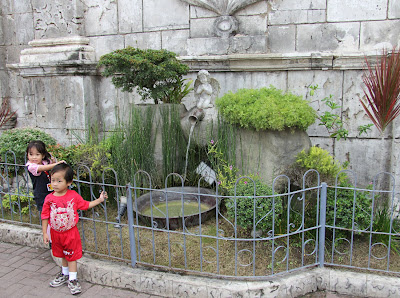The next day we headed towards the
Cebu Metropolitan Cathedral, a typical colonial Spanish church, squat and massive. Not one of my favourites, but still impressive with its thick white walls.
Next was the San Carlos University Museum
Unfortunately, taking photos was not allowed, so I can't show you any of it's exhibits. Lucky you :)
Although only one exhibition room was devoted to Cebu's prehistory (the other ones were filled with zoology, ethnography, and more recent history) it was quite interesting. I loved the secondary-burial boat coffins and the many limestone burial jars found in cave. These jars, some with lizard motives on them, some only with stripes, were also used for secondary burials. Secondary burials are known in the Philippines as bone washing. The body of the deceased is buried in earth and then after some time recovered, the bones washed and buried again in for example earthen jars, limestone jars or boat coffins. So it was a good day for me *hehe*
Since our hotel was booked out, we had to move to the
Crimson Beach Resort in Mactan. This is how our beach villa looked like from the outside
And this was behind the facade, our very own plunge pool :)
The Crimson Resort was utter bliss, a brilliant beach, a superb infinity pool, cool beach villas, the best spa
in the world; I had a deep tissue massage with hot stone therapy and the girl was sooo good, I felt like being in heaven afterwards. Besides, they have spa facilities which makes you feel like being in a Japanese
onsen (hot spring spa). The only downside was the restaurants; all shared the same menu and although there were some vegetarian dishes, with three vegetarians you have quickly eaten your way through the menu and it got soon very, very boring.
So we started using the shuttle bus to the
Ayala Mall, where loads of nice restaurants waited for us.
Out of curiosity we also wandered into the supermarket and marveled at the many different types of rice:
The Crimson Resort also offered a lot of beach activities and so we had a ride on the banana boat.
This is not us, but a photo from an Indonesian hotel site, but it shows what can happen when you ride the banana boat:
 |
| http://marbellaanyer.com/ |
you can imagine M and I got pretty wet :)
This night we also ritually killed a bad book. And I mean a really bad book:
If you ever want to read a German book about a 'detective' in ancient Rome, avoid this one. It was written by a teacher of Latin and it exactly sounded like a lesson in Latin. I don't want a recap on Cicero's Catiline Orations nor a history lesson on Cesar's achievements, all I wanted was a thrilling story about an abduction of a boy and how an unwilling wounded veteran gets interested and solves the case. You could really have done a nice story about it, but I haven't a read a more boring book in a long time. So we had to kill it to save other people from reading it.















































